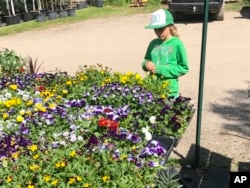From VOA Learning English, this is the Health & Lifestyle report.
If you want your children to become ready, willing, and able gardeners, take steps early. It is not difficult, but you might need to change your thinking about children in the garden.
That is one of the many suggestions made by Jeff Lowenfels. He writes about gardening for the Associated Press. Lowenfels says that gardeners are made, not born. He suggests several ways to help turn a child into a gardener.
The first step is to get your child interested in plants. This, he says, is getting more difficult because of competition from electronics.
Taking a child to a plant store is another good place to start. There they can smell the flowers and touch other plants.
Next, let your child buy a plant. Lowenfels says he still remembers the first plant his father helped him choose when he was six years old. He says that plant, called a lantana, is where his love of plants and gardening began to grow.
Teach your children well
Children not old enough to care for a plant by themselves, need adults to teach them. This may be the best way to get children interested in gardening. Children copy adults. So, let them see how much you enjoy working with plants.
Another great way to lead young people into gardening is to have them grow plants from seeds. This is very effective when the plants are things they like to eat. Carrots are favorites of many children.
Lowenfels suggests starting with larger seeds. Handling very small seeds may frustrate small children. He says there are plenty of seeds big enough for little fingers to pick up and plant. He suggests marigolds, cosmos, zinnias, sunflowers, corn, peas, and beans.
They are all also easy to start in containers as well as directly into the garden’s soil.
Give them a job
Don’t forget that children like responsibility. Find a gardening task that fits their age and is just for them.
They can fill containers with soil. You can show them how to water and how to place labels. You can also show them how to provide the right amount of light.
Small children can help in other ways. Lowenfels says his first garden job at age 5 was deadheading dandelion flowers into a container. To deadhead means to take dead flowers off a plant.
When his own children wanted to be in the garden, he gave them the job of hunting worms. Then they moved on to deadheading dandelions and pulling weeds.
Take it easy in the garden
Most important, however, is to have the proper attitude as head gardener and teacher.
Any adult teaching a child about gardening, he says, needs an easygoing, “go with the flow” attitude. If not, they could put a child off gardening forever.
Learning is about making mistakes. And with gardening that means stepping on plants and accidentally pulling things that are not weeds.
Lowenfels shares a story of his own daughter. At the time, she was 4 years old and was helping him prepare their flower garden for a flower show the next day. Unbeknownst to Lowenfels, she was following behind him and “cleaning up,” which to her meant removing all the flowers. Instead of getting angry, he simply put the flowers into containers and set them near the bare plants.
“Because of a little attitude adjustment on my part,” he writes, “40 years later, my daughter still loves to garden. And she is pretty good at floral arranging, too.”
And that’s the Health & Lifestyle report. I’m Anna Matteo.
Jeff Lowenfels reported this story for the Associated Press. Anna Matteo adapted it for VOA Learning English.
_______________________________________________________________
Words and Their Stories
garden - n. a plot of ground where herbs, fruits, flowers, or vegetables are grown
frustrate - v. to cause to feel angry or discouraged
label - v. a slip (as of paper or cloth) inscribed and affixed to something for identification or description
deadhead - v. to remove the faded flowers of (a plant) especially to keep a neat appearance and to promote reblooming by preventing seed production
weed - n. a plant that is not valued where it is growing and is usually of vigorous growth especially one that tends to overgrow or choke out more desirable plants
attitude - n. a mental position with regard to a fact or state
go with the flow - phrase to do what other people are doing or to agree with other people because it is the easiest thing to do
put off phrasal verb : to cause someone to lose interest
bare - adj. having nothing left over or added











